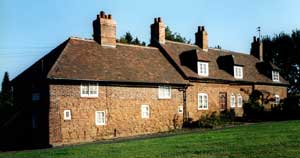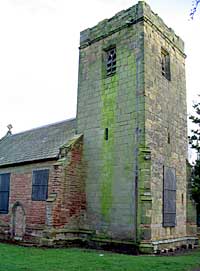
Cottages near Bilborough church.
IT is not known when coal-getting commenced at Bilborough but it must have been at an early date, for by the middle of the 16th century mines were being abandoned as exhausted. New ones were being sunk and when remaining old pits were deepened they were rendered unworkable by water. The (only practicable outfall lay on the Wollaton side, and when Sir Nicholas Strelley turned his "superfluous abundance of water" into an old sough that ran across Wollaton grounds Sir John Willoughby blocked up its course by a wall. The resultant quarrel was referred to the Star Chamber for settlement, and in1548 the two knights reached an agreement by which the Bilborough mines were to be drained by the Wollaton sough, three-quarters of the output from the new pit in the "Holluez " going to Sir John, the other fourth part to Sir Nicholas, the costs of production being payable in the same proportion.
Half a century later the Wollaton agent was in disgrace for the illicit sale of coal from this pit to Lady Stanhope and others, but from that time, at least, mining has shared predominance with agriculture, with chequered success. In 1797 Throsby stated that there were "considerable coal works in the lordship" leased to "a Mr. Walker and a Mr. Barber," and that coal was being obtained at a depth of 300 feet. It was then that the Beeston Canal was constructed, and a branch, known as the "Bilborough Cut,'' was made, which should have enhanced the local trade, but by 1811 the old pit was abandoned. The Hollywood Colliery had by then been opened, and to-day the Cinderhill Colliery Company raises large quantities from the local mines.
Legal Warfare.
The Strelley-Willoughby suit was by no means the only litigation in which the parish was concerned for with the Tudors a long series of law suits set in. About 1535 Sir Nicholas Strelley was prosecuting Sir John Markham, son-in-law of John Strelley, for detention of deeds. Soon after the accession of Queen Elizabeth, Sir Anthony Strelley was sued by Thomas Shelton and Dame Jane (Willoughby), his wife, respecting the manors of Strelley and Bilborough. Under James I Lady Ashburnham sued Sir Henry Beaumont and others for jointure in these manors and the coal mines there; Sir John Byron sued Nicholas Strelley and John Mitchell for the said manors and Shipley as leased to him by Philip Strelley; Sir John Mitchell petitioned for a writ against Sir George Peckham for refusing; "to fulfil an award made by arbitrators appointed by the Court of Chancery as to payment for the manors of Shipley and the sale of Bilborough and Strelley," in which the complainant was interested; and, a generation later, Judith Mitchell advanced against George Weldon and others a claim with regard to the manors of Strelley and Bilborough. Throughout all this litigation and other unnoticed suits the manor remained with the Strelleys until about 1678, when Aid. Ralph Edge, of Nottingham, acquired it with Strelley by purchase. Since then these manors have descended through several families who have successively assumed the name and arms of Edge.
At the Reformation the Bilborough possessions of the priories of Lenton and Newstead were granted to lay owners, and some of the inhabitants who witnessed that change would live to see the passing of the Romish priests, the establishment of the Church of England, and the advent of the Puritans. Under Elizabeth Broxtowe Hall was tenanted by Edmund Helwys, an earnest Puritan who gathered around him there many leaders of the new movement. They worshipped in the mother church of Bilborough where they would hear the new doctrines and behold the new ritual which so offended them. The story of the Helwys belongs to Broxtowe, but Edmund Helwys was buried in 1590 at the end of his "pue" in the aisle of this church, where a slab was provided by his son Thomas who also distributed his father's legacy to "20 poor cottagers of Basford, Bilburrowe, and Bulwell."
Thomas, who joined the Pilgrim Fathers later became a Puritan divine, and is the reputed founder of the first Baptist Church in England. He was married here in 1595 and here at least two of his children were baptised.
Religious Troubles.
Other religious troubles visited the parish. In 1573 the rector was deprived for irreverence. Under the Stuarts Popish recusants were recurrently being "presented," Sir George Peckham among them. In 1630 the churchwardens were brought to book for failing to pay the Pentecostal sixpence, and in 1638 the new sector was cited to the court of the archdeacon for "suffering the parsonage house to be in decay and utterlie ruinous." He was ordered to spend £10 upon its restoration and, failing to do so, was at last directed to put the work in hand forthwith and produce a certificate that this had been done. The repairs must have been slight for presently the parsonage was abandoned; the rectors then resided at Strelley, which they also served, and it was not until 1838 that the two parishes were legally united, to be followed in 1844 by the erection of a new rectory building beside Bilborough Churchyard.
The church is said to be dedicated to St. Martin, but according to some authorities St. Cuthbert is its real patron saint, the doubt arising from references in archiepiscopal mediaeval registers at York. Inasmuch, however, as the Middleton (Wollaton) archives contain records of the reign of Richard I showing that the local feast was held at Martinmas the ascription to St. Martin is doubtless, correct for feasts and dedications were closely allied, and the Priory Church at Worksop is the only church in the county, whose dedication to the Celtic Saint is undisputed.
The Church.

St Martin of Tours church, Bilborough.
Domesday mentions no church here, and the oldest remains in the present fabric date from about 1400, to which period the square-headed windows of the nave and chancel belong, but that there was an earlier building is certain as the list of known rectors commences with 1306. There are no aisles, but the blocked-up arch on the north side of the nave denotes the former existence of a chapel. In the 18th century the roof was lowered, and it may have been then that the flat ceiling: and the singers' gallery at the west end (both removed in 1877) were added. The porch is part of the original structure, but its roof belongs to later days. The tower was built about 1450, the east window being somewhat earlier, Stretton, who visited the church in 1819, found it in bad condition. In the nave were ten private pews "irregularly placed"; the chancel had "a most miserable appearance"; the floor was "very bad," and "three mouldering steps" led up to the decaying communion rails. Subsequent restorations have corrected these defects, but antiquaries regret that many ancient and interesting features have been ruined.
Although Broxtowe Hall, a mile away, was garrisoned for Parliament during the Civil War, and Aspley Wood Hall was held for the King, Bilborough escaped serious ravages of war. At the Restoration the Puritan "preaching minister" was ejected from the rectory, and later in the reign the manor changed hands. There was then one alehouse in the village, and a curious entry in the Quarter Sessions records relates that in 1685 the wife of John Brown was "suppressed from selling of ale at Bilborrow" and the alewife, who dwells away from her husband, "was returned to him at Radford."
In 1703 Dr. Robert Gray left £20 to be invested for the parish poor, but about 1718 the capital was improperly diverted for the repair of the church. More fortunate was the benefaction of Rd. Smedley, who in 1744 left a rent-charge of £5 a year for the education of poor children of Bilborough and Strelley who had "learned to battledore"; in 1828 a mistress was teaching twelve such children for a salary of £5; the endowment subsequently went to the church school. An Act was obtained in 1758 for the construction of a road to Alfreton, and a century later a local writer declared that "the flagged footpaths near Bilborough seem as if they have never been repaired." The enclosure took place in 1808 when 400a. at Bilborough and Strelley were enclosed and the 230a. of land then awarded to the rector in lieu of tithes were exchanged in 1838 for two messuages of land in Bleasby.
Modern Times.
Except for colliery development the 19th century annals of the parish were uneventful, but it may be noted that it was a period of decline in the number of inhabitants, for whereas, it had a population of 307 in 1801 this had dwindled to 202 by 1900. It may also be of interest to observe that "Capt." John Hutchinson, a hero of the Peninsular wars, who was shot beside Sir John Moore at Corunna, was buried here in 1809. In 1919 the parish was included in the abortive scheme for the extension of the city of Nottingham. To-day it retains its reputation for picturesque charm and is able to show a rare example of an old tithe-barn; near the entrance to Aspley Hall beside the Strelley-road is the base of an ancient boundary cross neighboured by a modern iron boundary mark of the Nottingham Corporation, and the track of the old-time colliery tram-line may yet be discerned leading across the fields to the site of the antique wharf at the junction of Broxtowe-lane and the Strelley-road.
